Photos with this report (click to enlarge) | |||
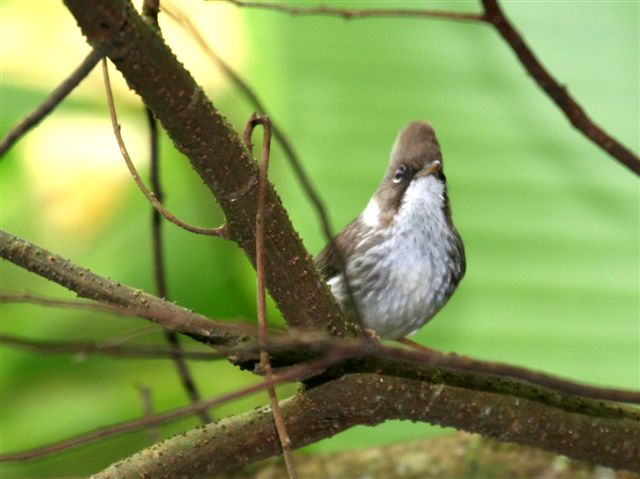 Burmese Yuhina |
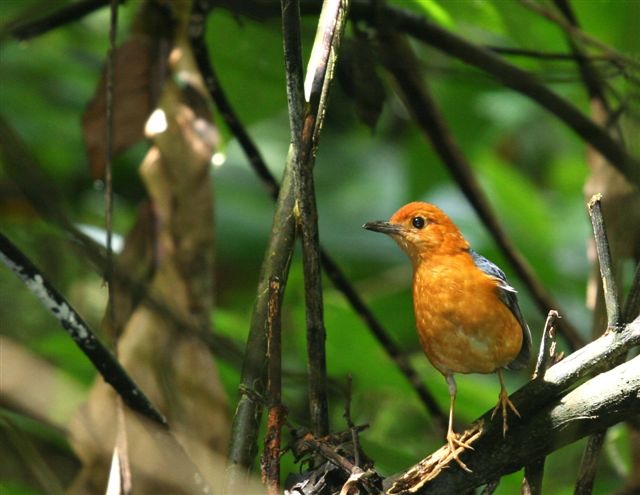 Orange-headed Thrush |
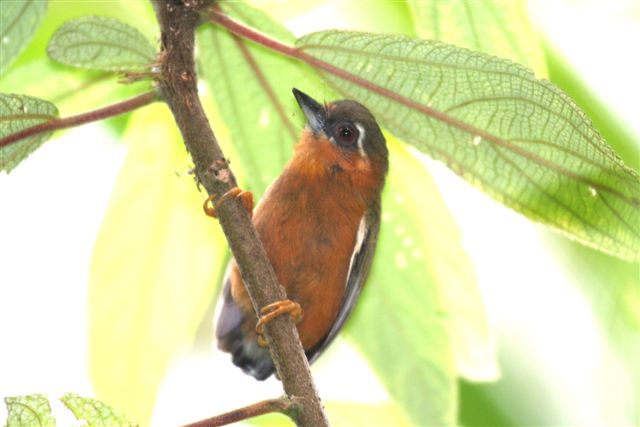 White-browed Piculet |
|
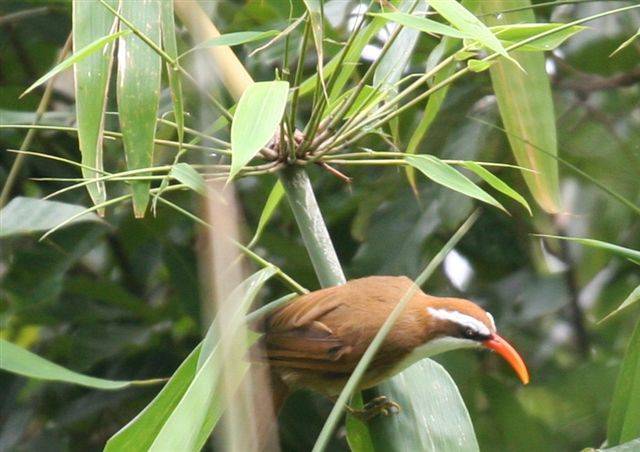 Red-billed Scimitar-babbler |
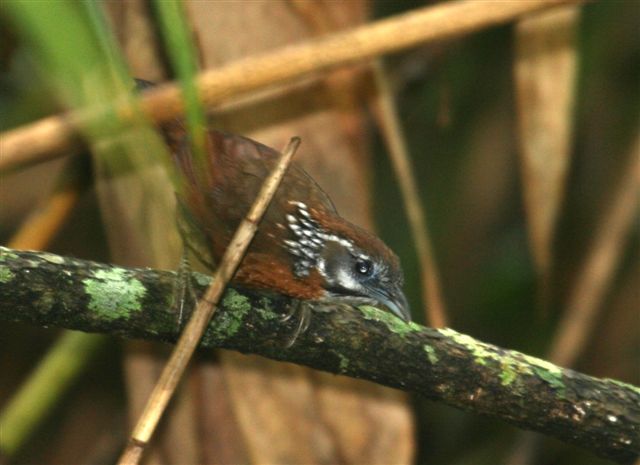 Spot-necked Babbler |
||
The Western Forest Complex of Thailand is the largest area of forest in the country, half way north between Bangkok and Chiang Mai, and includes numerous, large national parks and nature reserves, like Umphang Wildlife Reserve, Thung Yai Naresuan, and Huay Kha Kaeng, home to Green Peafowl, Wild Water Buffalo, and almost certainly Thailand’s largest population of tiger. This is a large area of remote wilderness and the only snag, of course, is that it is difficult to get in. One of the best ways to get at least to the edge is at Mae Wong National Park.
Chong Yen campsite, at 1350m, is in an area that used to be inhabited by hill tribes. You can still see signs of terraces on the steep hills, but the cultivated areas are overgrown with tall grass and scrub. There are patches of forest on the drive up, but when you get to the ridgetop at Chong Yen, you are rewarded with a view to the west over almost unbroken mountain forest, and you can even walk into the forest a short way if the trails are clear.
Directions – Chong Yen campsite is 420km from Bangkok. To get there, drive north and, about 20km north of Nakorn Sawan, turn left toward Lat Yao. After driving through the central market of Lat Yao (almost another 25km), you reach a T-junction. Turn right. Then drive just over 40km on a rather annoying road through numerous villages until you reach a crossroads. Turn right again (if you go straight here, you will get to a checkpoint and a more southern section of Mae Wong NP). Go through the next crossroads, a couple of km further on, then drive another 32km to a crossroads in a large village. Turn left; this road leads 12km to the park entrance.
You have to buy the park entrance tickets right at the park entrance, but tickets to camp at Chong Yen are sold separately at the park Headquarters. The Headquarters area, including a campsite, cafeteria, visitors centre and administrative offices is a right turn after about another 8km past the park entrance. If you are in a group and staying more than a day, expect to end up with a big stack of paper slips. Once the bureaucracy is done with, you can pass through the entrance gate and drive the final 30km up to Chong Yen.
Timing –Thai parks are popular, a fact that is difficult to miss if you visit any on a weekend. In the cool season (November to February), and to a lesser extent in the dry season (February to April), Chong Yen is packed on Saturday nights. Most of the 4WDs snake up the road early Saturday afternoon and the whole place turns into a sea of tents. I was once offered a cup of whisky after getting out of my tent 6am on Sunday morning. But the whole place is empty again by early afternoon on the Sunday.
In the wet season, and during weekdays, the place is normally empty. But there should still be a few cars going up the road every day, and there is a reasonable chance you could hitch a ride if you need one.
I’ve run into groups of Thai birders a few times at Chong Yen, but don’t recall ever seeing a Western birder there.
This is a lush mountain area, and you can get torrential rain during the wet season. Sometimes it lasts all day. In the cold season, it can get chilly at night.
Insects are a nuisance all year here. The specialty are “koon”, small round flies with black and yellow stripes. Chong Yen has lots, and, if it is a quiet time for other visitors, you will find yourself to be the only banana in the supermarket. Koon bore a small round hole into your arm or neck and can go about their business for a while without you noticing them at the time. But their efforts create small, bloody welts that can later become quite itchy.
Other predators include plenty of tiny “no-see-ums” (smaller than the koon), stripy green leeches (especially in wet season), which would be quite attractive under other circumstances, and, of course, mosquitos.
Equipment – The only facilities at Chong Yen are the campsite, bathrooms, and some picnic tables. You’ll need to bring camping gear, food and water.
A machete might be useful, because the trails are often overgrown with briars.
One of those electric “tennis rackets” comes in very handy for dealing with the koon. Pop pop pop.
Etiquette – The rangers will always appreciate you coming in to say hi. Many are interested in birds, and/or may suggest you take one of them along for safety reasons if you are on your own. They once managed to fix my car very effectively after steam started coming out of the hood half way up the mountain.
Paths – A nice, small trail starts from behind the bathrooms and travels downhill gradually through scrub and forest passing a number of small gullies populated by banana trees. (I will call this “Umphang trail”, since I guess it goes in this direction)
Another trail leaves from the left side of the rangers’ bungalows; it goes downhill more steeply through the forest interior. I have heard these trails may join up at a waterfall, a few km down the mountain, but I’ve never got this far. (I will call this “forest trail”)
The last part of the access road can also be good for birds. It is mostly through open grass and scrub, but there are a couple of large forested gullies in the last couple of km before Chong Yen, and the final steep section up to the campsite is on the edge of the forest. (I will call this “access road”).
Birds and mammals – Most of the information is in the species list, but I will mention a few sightings of special interest.
Burmese Yuhina – Chong Yen is one of the few accessible spots in Thailand for this bird. It normally inhabits even higher altitudes, but none of the roads in Thailand go this high. One of the other spots is supposedly about 50km before Umphang on the Mae-Sot Umphang road. It is very close to Mae Wong as the crow flies, but is a much longer drive from Bangkok, since you have to get there via Mae Sot and a long windy road south of the town. I think the altitude is slightly lower than at Chong Yen. I have only seen a pair of Burmese Yuhina once at Chong Yen. Striated Yuhina are common here in canopy here, and can look like Burmese Yuhina on poor views. I hear that Burmese Yuhina are commoner at the summit of Doi Mokoju in Mae Wong National Park, at an altitude of nearly 2000m. This is a two-day hike in each direction, and starts from Mae Wong HQ. It needs to be done near the end of the wet season or in the early part of the cool season, when the streams are full, but seems to be a popular trek that can be organized quite routinely at this time of year (although you might need to book the porters and guides in advance).
Hornbills – Chong Yen is also the best-known site in Thailand for Rufous-necked Hornbill. Groups (sometimes quite large) turn up sporadically at Chong Yen, but they are more regular near the end of the wet season (normally August and September) since I hear there are many fruiting forest lychees in the area of the campsite. The only time I got good numbers (groups of 15-20 flying over and perched) was during a trip in July 2005. There are often a couple of Great Hornbill around Chong Yen, and I once saw three Wreathed Hornbill on the drive up.
Pittas and broadbills – There are a few calling Rusty-naped Pitta around Chong Yen. I’ve had them maddeningly close on a number of occasions, calling from the ground seemingly only a few metres away, but they’ve never responded to playback, just calling invisibly for a minutes before vanishing. I’ve also heard Blue Pitta occasionally at Chong Yen. Blue-winged Pitta inhabits the lower areas of the park in the wet season, and is the only species I’ve actually seen here. Long-tailed Broadbill is fairly common around Chong Yen, and I’ve heard Silver-breasted Broadbill a few times.
Pheasants and partridges – Bar-backed and Rufous-throated Partridges are both common near Chong Yen. I once saw a group of three Kalij Pheasant in fairly unattractive-looking habitat about 10km past the park Headquarters on the drive up. In the dry season, you can hear Gray Peacock-Pheasant calling from the gully below Chong Yen.
There are millions of babblers around Chong Yen, including many species that are scarce in the rest of Thailand. These include White-browed, Red-billed and Coral-billed Scimitar-babblers, White-necked, Black-throated and Chestnut-capped Laughingthrushes, Long-tailed Sibia, Silver-eared Mesia, Streaked and Eyebrowed Wren-Babblers, Grey-throated, Golden, Spot-necked and Buff-breasted Babbler, Chestnut-fronted and White-browed Shrike-Babblers, Blue-winged Minla, White-hooded Babbler, Burmese, White-bellied and Striated Yuhinas.
The Umphang trail is good for some interesting birds that like hanging out near small rivulets, like Rufous-browed Flycatcher, White-crowned Forktail, White-tailed Robin, Small Niltava, and (I suppose) the Rusty-naped Pitta.
Orange-headed Thrush is present in the wet season. I once saw Dark-sided Thrush a short way below Chong Yen, and have heard Green Cochoa right at the campsite.
Large mammals are fairly thin on the ground, but I’ve seen a troupe of Stump-tailed Macaques immediately below Chong Yen, a group of Red Muntjac quietly crossing the Umphang trail (unlike Khao Yai, they don’t walk around on the lawns here!). Phayre’s Langur can often be heard calling.
One interesting mammal sighting I had here was of Stripe-backed Weasel. The few previous Thai records were from north-east Thailand, but I had one practically step on my foot after going a short way off-trail down the “Umphang trail”. It seemed to be attracted by my shiny, metallic minidisk player (which I’d just put down on the ground after using – unsuccessfully – to try to attract a nearby calling a Rusty-naped Pitta). The weasel came up and sniffed it a couple of times, made a noise a bit like a fairly high pitched human sneeze, then casually wandered off.
The forest near Headquarters is quite dry, with lots of bamboo and a small area of dipterocarp just past headquarters. The stream right by the Headquarters is supposed to be a good spot for Crested Kingfisher (flying along the stream at dawn and dusk) although I’ve never seen it.
Chinese Pond-Heron – Around Headquarters
Striated Heron – On the stream by Headquarters
Black-shouldered Kite – Once at Chong Yen
Crested Serpent-Eagle – Fairly common
Shikra – One a few km past Headquarters
Kalij Pheasant – Once a group of three at dusk on the road up to Chong Yen, about 10km past Headquarters
Red Junglefowl – Quite common, especially in the grass and scrubland, including one sighting of an eclipse male
Gray Peacock-Pheasant – Can be heard from the gully below Chong Yen
Rufous-throated Partridge – Frequently heard and two seen around Chong Yen
Bar-backed Partridge – Frequently heard and seen several times around Chong Yen
Green pigeon sp. – Sometimes heard
Mountain Imperial Pigeon – Common around Chong Yen (sometimes abundant)
Barred Cuckoo-Dove – One seen and a few heard
Emerald Dove – Sometimes flushed from the road up to Chong Yen
Vernal Hanging-Parrot – A flyover once at Chong Yen
Greater Coucal – Common in the grass and scrub, and by the side of the road up to Chong Yen
Green-billed Malkoha – Common in forest and scrub at all altitudes
Mountain Scops-Owl – Several around Chong Yen (e.g., final gully on the access road)
Collared Scops-Owl – One calling often from the hillside immediately above the campsite
Asian Barred Owlet – Heard once at a lower elevation
Collared Owlet – Heard most days
Brown Wood-Owl – Once heard just below Chong Yen
Large-tailed Nightjar – Common on the roads at lower elevations
Indochinese Swiftlet – Groups can sometimes be seen hawking over grassy areas in the wet season
Asian Palm-Swift – These turn up at all elevations in the park
Banded Kingfisher – Once heard from the middle section of the road between HQ and Chong Yen
White-throated Kingfisher – Sometimes common on the road between HQ and Chong Yen, on the road in grassland areas, or by streams in lower areas
Red-headed Trogon – Heard once at Chong Yen
Chestnut-headed Bee-eater – A group of these sometimes appears around Chong Yen campsite
Blue-bearded Bee-eater – A pair of these were breeding in the mud bank by the side of the road on the final ascent to Chong Yen, and could often be seen sitting in the trees in this area
Indian Roller – Common in grassland and scrubland
Rufous-necked Hornbill – Sporadic at Chong Yen campsite, I head they are most often present in August and September (although my only large groups were in July 2005)
Wreathed Hornbill – 3 seen flying over the road to Chong Yen (about 10km before the campsite)
Great Hornbill – One or two often around Chong Yen
Great Barbet – Common around Chong Yen
Lineated Barbet – Heard at lower elevations
Golden-throated Barbet – Abundant around Chong Yen
Blue-throated Barbet – Sometimes heard or seen at Chong Yen
Speckled Piculet – Common (a few seen almost every visit)
White-browed Piculet – Quite common (seen most visits)
Greater Flameback – A couple seen lower down the access road
Greater Yellownape – A few around Chong Yen
Lesser Yellownape – Seen twice (once 15km before Chong Yen)
Bay Woodpecker – Often heard and sometimes seen around Chong Yen
Stripe-breasted Woodpecker – Probably the commonest woodpecker at Chong Yen
Silver-breasted Broadbill – Groups sometimes heard around Chong Yen
Long-tailed Broadbill – Fairly common (seen on about half of the visits)
Rusty-naped Pitta – Seemingly quite common, at least 4 calling birds in the gullies below Chong Yen, but I never managed to see it
Blue Pitta – One or two heard around Chong Yen
Blue-winged Pitta – Heard and easily seen along the access road, just past headquarters
Asian House-Martin – About 10 birds seen once at Chong Yen
Forest Wagtail – 2 seen
Gray Wagtail – Once abundant (late July 2005)
Bar-winged Flycatcher-shrike – Frequent in mixed flocks, especially in the lower regions of the park
Black-winged Cuckoo-shrike – Sometimes in mixed flocks at Chong Yen (all my records were in the winter)
Gray-chinned Minivet – Common around Chong Yen
Scarlet Minivet – Common around Chong Yen
Orange-bellied Leafbird – Common around Chong Yen
Black-crested Bulbul – Common in the lower regions of the park
Black-headed Bulbul – Seen twice at Chong Yen
Red-whiskered Bulbul – A few seen in grassland areas
Sooty-headed Bulbul – Seen once near Headquarters
Flavescent Bulbul – Abundant in the grassland around Chong Yen, and even in small areas of grass along the Umphang trail
Olive Bulbul – Once seen in a fruiting tree along the access road just below Chong Yen (at about 1300m). Heard sometimes in the lower regions of the park.
Ashy Bulbul – Frequent, a couple once seen only a short way past Headquarters
Mountain Bulbul – Sometimes abundant at Chong Yen
Black Bulbul – Groups of these sometimes turn up in the more open forest areas (e.g., final gullies along the access road, or open areas along the Umphang trail)
Ashy Drongo – Common around Chong Yen
Bronzed Drongo – The most common drongo around Chong Yen and also at lower altitudes
Spangled Drongo – 2 seen near Chong Yen (April 2006)
Lesser Racket-tailed Drongo – Common at Chong Yen
Greater Racket-tailed Drongo – Sometimes seen in lower regions of the park
Maroon Oriole – Chong Yen is a good site for this, and all the birds I have seen here were males
Gray Treepie – Quite common around Chong Yen, and even in quite small patches of forest along the upper part of the access road
Green Magpie – Often heard and sometimes seen at lower elevations
Yellow-cheeked Tit – Fairly common around Chong Yen (although not seen on every trip)
Velvet-fronted Nuthatch – Fairly common around Chong Yen (although not seen on every trip)
Puff-throated Babbler – Common (by voice) in the lower regions of the park
Buff-breasted Babbler – Common around Chong Yen, and a few heard right down to Headquarters.
White-browed Scimitar-babbler – Common around Chong Yen, seen on every visit
Red-billed Scimitar-babbler – Uncommon around Chong Yen (only two groups in several visits, one flock including White-hooded Babbler)
Coral-billed Scimitar-babbler – Uncommon around Chong Yen
Streaked Wren-Babbler – A few groups recorded, twice in the final gully along the access road, once along the Umphang trail
Rufous-fronted Babbler – Seen in lower areas of the park
Golden Babbler – Common around Chong Yen
Gray-throated Babbler – Common around Chong Yen
Spot-necked Babbler – Uncommon at Chong Yen, although 5 seen on my last visit in June 2006. One pair seemed to be nesting in the banana grove right as the access road enters Chong Yen campsite.
Striped Tit-Babbler – Common at elevations
Greater Necklaced Laughingthrush – A group (with Green Magpies) seen once in the lowlands, about 5 km past Headquarters
White-necked Laughingthrush – Noisy groups are almost always calling around Chong Yen, probably one of the best sites in Thailand for this bird
Black-throated Laughingthrush – A few in the bushes immediately around Chong Yen campsite
Chestnut-crowned Laughingthrush – Fairly common around Chong Yen, but very secretive (unlike those at the summit of Doi Inthanon)
Gray-cheeked Fulvetta – Abundant in forest around Chong Yen
Brown-cheeked Fulvetta – A few heard at lower elevations in the park
Striated Yuhina – Flocks in the treetops around Chong Yen on most visits
Burmese Yuhina – Only one pair seen, near the top of the “Umphang Trail” in April 2006
White-bellied Yuhina – Seen once at Chong Yen
Chestnut-fronted Shrike-Babbler – A few seen around Chong Yen
White-fronted Shrike-Babbler – Fairly common around Chong Yen, a few seen on almost every visit
Blue-winged Minla – A few seen
Silver-eared Mesia – Common around Chong Yen
White-hooded Babbler – One seen in the banana grove at the entrance to Chong Yen campsite (in a flock of Red-billed Scimitar-babblers)
Black-headed Sibia – A few heard around Chong Yen
Long-tailed Sibia – A few groups seen along the access road to Chong Yen (especially in the final gully)
Dark-necked Tailorbird – Seen once about 10km past park Headquarters
Yellow-bellied Warbler – A few seen along the lower sections of the road up to Chong Yen
Radde’s Warbler – Fairly common in winter
Blyth’s Leaf-Warbler – A few seen well around Chong Yen in winter, but difficult to separate from White-tailed
White-tailed Warbler – Common at Chong Yen, normally in mixed flocks with fantails, gray-headed flycatcher etc
Inornate Warbler – Common in winter, especially around park Headquarters
Rufescent Prinia – Common in grassy and scrubby areas along the access road, especially at lower elevations
Hill Prinia – A few in grassy areas just downhill from Chong Yen
Slaty-bellied Tesia – Around small streams near Chong Yen (Umphang and forest trails)
Oriental Magpie-Robin – Common in grassy and scrubby areas along the access road
White-rumped Shama – Common in secondary forest at lower elevations
White-tailed Robin – A few down the Umphang trail
White-crowned Forktail – Commonly seen along roads and trails during the wet season
Green Cochoa – Heard (April 2006) around Chong Yen campsite, and near a fruiting tree a short way down the Umphang trail
Pied Bushchat – Common in grassy areas along the access road
Blue Whistling-Thrush – Sometimes appears at Chong Yen (both races)
Orange-headed Thrush – A pair seen in June 2006 in the final gully before Chong Yen, so presumably this species breeds in the area
Dark-sided Thrush – Once seen running along the access road during a period of very heavy rain, in the penultimate gully before Chong Yen.
Red-throated Flycatcher – Common in winter
Rufous-browed Flycatcher – A few down the Umphang trail
Gray-headed Flycatcher – Abundant around Chong Yen
Small Niltava – Seen almost every visit, especially down the Umphang trail
Verditer Flycatcher – Often in the treetops around Chong Yen
White-browed Fantail – Common around Chong Yen
Black-naped Monarch – Common at lower elevations
Ashy Woodswallow – Around Headquarters
Brown Shrike – Common in winter in grassy areas, including at Chong Yen
Hill Myna – A couple on top of a dead tree, about 5km past Headquarters
Black-throated Sunbird – Common around Chong Yen
Little Spiderhunter – A few around Chong Yen and at lower elevations
Streaked Spiderhunter – Abundant around Chong Yen
Buff-bellied Flowerpecker – A few around Chong Yen
Thick-billed Flowerpecker – A pair once in dry forest a few km past Headquarters
Chestnut-flanked White-eye – Common in winter around Chong Yen, including in the trees above the picnic tables
Oriental White-eye – Common around Chong Yen
White-rumped Munia – Small groups seen a couple of times in the grassland